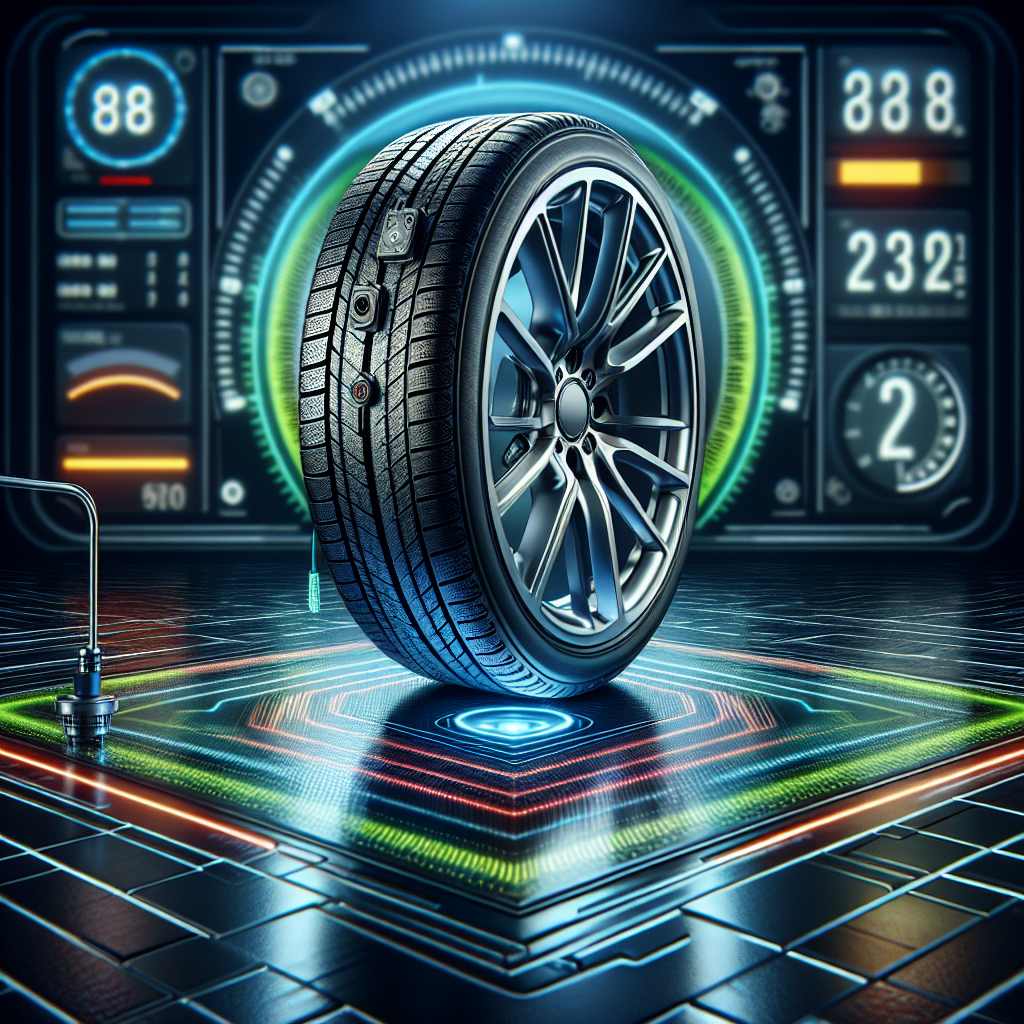Tire Pressure Monitoring Systems (TPMS) are essential components in modern vehicles, designed to enhance safety and efficiency on the road. At their core, these systems monitor the air pressure in your tires in real-time, ensuring they remain within the optimal range. Maintaining proper tire pressure is crucial, as under-inflated tires can lead to increased wear, reduced fuel efficiency, and even hazardous driving conditions.
TPMS typically operates using one of two methods: direct or indirect monitoring. With direct TPMS, sensors installed within each tire measure the exact pressure and relay this information to the vehicle's onboard computer. In contrast, indirect TPMS does not use specific pressure sensors; instead, it measures the rotational speed of the tires via the anti-lock braking system (ABS) to estimate tire pressure.
Some advantages of having a TPMS include:
- Enhanced Safety: A properly functioning TPMS alerts drivers to low tire pressure, reducing the risk of blowouts.
- Fuel Efficiency: Maintaining optimal tire pressure can enhance fuel economy, saving you money on gas.
- Longer Tire Life: Regular monitoring helps in extending the lifespan of your tires by preventing uneven wear.
Investing in a TPMS is a proactive approach to vehicle maintenance. For trailer owners, integrating a TPMS can significantly improve safety during transport. Tow with peace of mind, knowing that trailerwatchdog is standing guard.
How TPMS Technology Detects Tire Pressure Changes

The technology behind Tire Pressure Monitoring Systems (TPMS) is both innovative and efficient. Understanding how TPMS detects tire pressure changes can provide valuable insights into its operation and benefits. At the heart of this technology are sensors that play a crucial role in monitoring tire conditions.
In direct TPMS, each tire is equipped with a small sensor that continuously measures the tire’s air pressure. These sensors are typically located on the valve stem and communicate wirelessly with the vehicle's onboard computer system. When tire pressure deviates from the recommended levels, these sensors send alerts to the driver, often through a dashboard warning light.
Indirect TPMS, on the other hand, relies on the vehicle's ABS to gather data. By monitoring the rotational speed of each tire, the system can infer whether a tire is under-inflated. When a tire loses pressure, it becomes smaller and rotates faster than properly inflated tires, prompting the system to issue a warning.
Additionally, many TPMS technologies are designed to be highly sensitive, capable of detecting even slight variations in tire pressure. This sensitivity is critical, as tires can lose pressure gradually over time or suddenly due to a puncture. The faster a driver is alerted to a pressure drop, the safer their driving experience will be.
Overall, TPMS technology represents a significant advancement in vehicle safety, providing real-time data that helps drivers make informed decisions regarding tire maintenance and safety.
The Importance of Maintaining Proper Tire Pressure

Maintaining proper tire pressure is essential for the safety and efficiency of any vehicle. Tires that are either over-inflated or under-inflated can lead to a range of problems, including reduced fuel efficiency, uneven tire wear, and an increased risk of blowouts.
**Fuel Efficiency:** One of the most significant impacts of incorrect tire pressure is on fuel economy. Under-inflated tires create more rolling resistance, which means the engine has to work harder to move the vehicle. Studies have shown that keeping tires properly inflated can improve fuel efficiency by up to 3%.
**Tire Longevity:** Proper tire pressure also extends the life of tires. Tires that are consistently under-inflated may wear unevenly, leading to premature replacement. Conversely, over-inflated tires can lead to a harsher ride and increase the likelihood of damage from potholes or road debris.
**Safety:** Perhaps most importantly, maintaining the correct tire pressure is vital for vehicle safety. Tires that are not inflated to the recommended levels can significantly affect handling and braking performance. Low tire pressure can lead to decreased traction, making it harder to control the vehicle, particularly in adverse weather conditions.
Regularly checking tire pressure and ensuring that it is within the manufacturer’s specifications can help prevent these issues. By being proactive about tire maintenance, drivers can enhance both their safety and the performance of their vehicles.
Types of TPMS: Direct vs. Indirect Systems Explained

Tire Pressure Monitoring Systems (TPMS) come in two primary types: direct and indirect systems. Understanding the differences between these systems is crucial for anyone looking to maintain optimal tire pressure and enhance vehicle safety.
**Direct TPMS:** This system utilizes individual sensors mounted on each tire, which directly measure the tire's pressure. These sensors transmit real-time data to the vehicle's onboard computer, allowing drivers to see precise tire pressures for each tire. The advantages of direct TPMS include:
- More accurate pressure readings
- Rapid detection of pressure loss
- Ability to monitor temperature along with pressure
However, one downside is that if a sensor fails, it can be costly to replace. Additionally, some systems require periodic battery replacements, which can add to maintenance costs.
**Indirect TPMS:** In contrast, indirect TPMS does not use pressure sensors. Instead, it relies on the vehicle's existing wheel speed sensors to estimate tire pressure based on the rotational speed of each tire. If a tire is under-inflated, it will rotate faster than its properly inflated counterparts. The benefits of indirect TPMS include:
- Lower installation and maintenance costs
- Less complex systems, leading to fewer points of failure
However, indirect systems may not provide as accurate or timely information as direct systems, and they often require recalibration after tire rotations or replacements.
Ultimately, the choice between direct and indirect TPMS will depend on individual needs, budget considerations, and the specific requirements of the vehicle.
Common TPMS Warning Signs to Watch For

Being aware of the common TPMS warning signs is essential for maintaining both safety and performance while driving. Recognizing these signs early can help prevent tire-related incidents and ensure a smoother ride.
**1. Warning Light Activation:** The most straightforward sign is when the TPMS warning light illuminates on your dashboard. This light typically resembles a tire with an exclamation mark inside. If this light activates, it indicates that one or more tires may be under-inflated.
**2. Fluctuating Tire Pressure Readings:** For vehicles equipped with a direct TPMS, sudden changes in tire pressure readings can signal a potential issue. If you notice your tire pressure is dropping consistently, it could indicate a leak or other malfunction.
**3. Uneven Tire Wear:** Inspecting your tires for uneven wear patterns can also reveal underlying problems. If certain areas of the tread are wearing down faster than others, this may suggest incorrect tire pressure levels, which can trigger a TPMS warning.
**4. Vibration or Pulling:** If your vehicle starts to vibrate or pull to one side while driving, it could be a sign of low tire pressure. This instability can activate the TPMS warning light and should be addressed immediately.
**5. Unusual Noises:** Listen for any strange noises coming from the tires. A hissing or bubbling sound might indicate a puncture or slow leak, which can lead to a TPMS alert.
Keeping an eye on these warning signs will help you address tire issues before they escalate into more significant problems. Regular maintenance and checks are vital for ensuring your TPMS functions correctly and keeps your vehicle safe on the road.
How Trailer Monitoring Systems Enhance TPMS Effectiveness
Integrating a trailer monitoring system with your TPMS significantly enhances its effectiveness, providing real-time insights that help maintain optimal tire pressure and axle temperature. This combination not only improves safety but also boosts efficiency during travels.
**1. Real-Time Data Monitoring:** A robust trailer monitoring system continuously tracks tire pressure and temperature, ensuring you have up-to-date information at your fingertips. This means you are alerted instantly if pressure drops below safe levels, allowing for proactive measures.
**2. Early Detection of Issues:** By monitoring temperature alongside tire pressure, these systems can identify early signs of potential tire failure or overheating issues. This dual monitoring capability is crucial in preventing catastrophic failures that could lead to accidents.
**3. Data Logging for Maintenance:** Advanced trailer monitoring systems offer data logging features, which allow you to keep track of historical tire pressure and temperature data. This information is invaluable for maintenance schedules and can help diagnose recurring issues.
**4. Enhanced Communication:** Many modern systems can connect to your smartphone or vehicle’s dashboard, providing alerts and notifications. This connectivity ensures you’re always informed, even when you're away from the trailer.
**5. Increased Fuel Efficiency:** Maintaining optimal tire pressure not only prolongs tire life but also improves fuel efficiency. A well-monitored trailer results in lower rolling resistance, leading to better fuel economy on long hauls.
Tow with peace of mind, knowing that trailerwatchdog is standing guard. Our trailer monitoring system ensures your tires and axles are in top condition, keeping you safe and efficient on the road.

